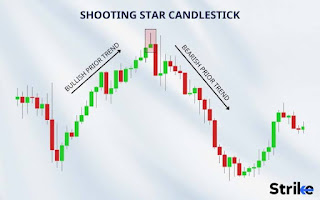The Shooting Star Candlestick Pattern
.jpeg)
### The Shooting Star Candlestick Pattern #### Description The Shooting Star is a bearish reversal candlestick pattern that typically appears at the top of an uptrend. It is characterized by a small real body near the lower end of the trading range, a long upper wick (shadow), and little or no lower wick. The long upper wick indicates that the market opened, rallied significantly, but then gave up most of the gains to close near the opening price. #### Characteristics - **Small Real Body**: Indicates minimal difference between the opening and closing prices. - **Long Upper Wick**: Reflects strong upward movement that was not sustained. - **Short or Absent Lower Wick**: Suggests limited lower price movement during the period. #### Significance The Shooting Star pattern signals that buyers initially drove prices higher, but sellers regained control, pushing prices back down. This shift in momentum from bullish to bearish suggests a potential reversal from an uptrend to a downtrend. ...
.jpeg)
.png)
.jpeg)
.jpeg)

.jpeg)